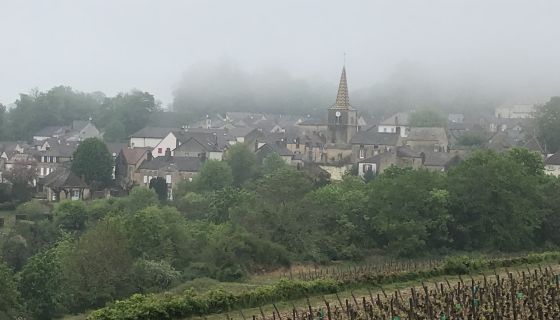Driving up towards Corton-Charlemagne on 3 June, I was surprised to see brown earth between the vine-rows, where normally fresh green leaf-growth would be covering whole hillsides. May had been very cold and wet, pushing the flowering into June, whose first week was pleasant – neither too wet and cold nor too hot.
Then a heatwave arrived, with daytime temperatures rising to 29–31 °C over four or five days. Vineyard growth started to gallop ahead, fuelled by all the May rain. Growers were hard at it, securing double wires around the growing shoots, attaching branches, then clipping vegetation. A lot of flowering took place during hot, dry weather, so one might hope that a good flowering would partly compensate for the crop losses engendered by the devastating frosts in early April? These frosts had affected Chardonnays more seriously than Pinots (which generally come into leaf later).
The frosts had caught the breaking young leaves and buds, and the unsettled, cool weather which followed meant that many bunches did not develop well, and second shoots failed to materialise – so we are looking at a much-reduced 2021 harvest.
The frosts affected Chardonnays in strange ways. Domaine Blain-Gagnard in Chassagne-Montrachet report that they may have lost 65% of a normal crop in the premiers crus La Boudriotte and Cailleret, where La Grande Montagne (higher up the hill) is 90% affected. Their grands crus and village-level wines were less damaged. Informally, I gathered that Domaine Leflaive may be looking to produce 40% of a normal crop. In Pernand-Vergelesses, April frost damage looks less serious than in 2016, and is unevenly spread across different bands on its varied hillsides. The harvest may start around 20 September, it is currently thought.
Because of regular, intermittent June rains, it has been difficult, sometimes impossible, to get tractors between the rows to spray to prevent mildew. Cold weather has largely kept mildew at bay but the risk remains, and damp weather has continued through the first week of July. So far, no hail, in spite of several thunderstorms, including a spectacular electric storm over the northern Côte de Beaune at 10 pm on Saturday 19 June, which we watched as we would a fireworks display, followed by heavy rains.
It turned noticeably cooler in Burgundy during the last week of June during the annual Festival Musique et Vins. There were six spectacular concerts at the Clos Vougeot, the Église de Meursault and the Halles de Beaune, all being possible – with restricted numbers – as France’s curfew had been lifted. Growers were thrilled to pour their wines at the pre-concert tastings after so many months of lockdown. Other pleasures of being in Burgundy this June have been the spectacular, long-lasting roadside poppies, pale blue irises and many-coloured rambling roses, their seasons extended by the clement temperatures.
Across the region, growers have been affected by frost, rain and lack of sun but – so far – not hail. Jeremy Seysses at Domaine Dujac in Morey-St-Denis confirms that sometimes it has been possible to get into the vines with a tractor only one day a week, so you have to hope your tractor does not break down that day! There has been no summer heatwave as yet, and the buds and shoots have been fragile.
Cyrille Harmel, export director of Maisons & Domaines Henriot took the picture below this morning, 8 July 2021.















